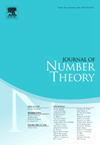Non-vanishing of a certain quantity related to the p-adic coupling of mock modular forms with newforms
IF 0.7
3区 数学
Q3 MATHEMATICS
引用次数: 0
Abstract
Several authors have recently proved results which express a cusp form as a p-adic limit of weakly holomorphic modular forms under repeated application of Atkin's U-operator. Initially, these results had a deficiency: one could not rule out the possibility when a certain quantity vanishes and the final result fails to be true. Later on, Ahlgren and Samart [1] found a method to prove the non-vanishing in question in the specific case considered by El-Guindy and Ono [10]. Hanson and Jameson [15] and (independently) Dicks [8] generalized this method to finitely many other cases.
In this paper, we present a different approach which allows us to prove a similar non-vanishing result for an infinite family of similar cases. Our approach also allows us to return back to the original example considered by El-Guindy and Ono [10], where we calculate the (manifestly non-zero) quantity explicitly in terms of Morita's p-adic Γ-function.
仿模形式与新模形式的p进耦合关系到一定数量的不消失
最近,几个作者在重复应用Atkin的u算子的情况下,证明了用弱全纯模形式的p进极限表示尖形的结果。最初,这些结果有一个缺陷:不能排除某一数量消失而最终结果不正确的可能性。后来,Ahlgren和Samart[1]找到了一种方法来证明El-Guindy和Ono[1]所考虑的特定情况下的不消失性。Hanson和Jameson[8]和Dicks[8](独立地)将这种方法推广到有限的许多其他情况。在本文中,我们提出了一种不同的方法,它允许我们证明一个类似的不消失的结果对于无限族的类似情况。我们的方法还允许我们回到El-Guindy和Ono[10]所考虑的原始示例,其中我们根据Morita的p进Γ-function明确地计算(明显非零)数量。
本文章由计算机程序翻译,如有差异,请以英文原文为准。
求助全文
约1分钟内获得全文
求助全文
来源期刊

Journal of Number Theory
数学-数学
CiteScore
1.30
自引率
14.30%
发文量
122
审稿时长
16 weeks
期刊介绍:
The Journal of Number Theory (JNT) features selected research articles that represent the broad spectrum of interest in contemporary number theory and allied areas. A valuable resource for mathematicians, the journal provides an international forum for the publication of original research in this field.
The Journal of Number Theory is encouraging submissions of quality, long articles where most or all of the technical details are included. The journal now considers and welcomes also papers in Computational Number Theory.
Starting in May 2019, JNT will have a new format with 3 sections:
JNT Prime targets (possibly very long with complete proofs) high impact papers. Articles published in this section will be granted 1 year promotional open access.
JNT General Section is for shorter papers. We particularly encourage submission from junior researchers. Every attempt will be made to expedite the review process for such submissions.
Computational JNT . This section aims to provide a forum to disseminate contributions which make significant use of computer calculations to derive novel number theoretic results. There will be an online repository where supplementary codes and data can be stored.
 求助内容:
求助内容: 应助结果提醒方式:
应助结果提醒方式:


